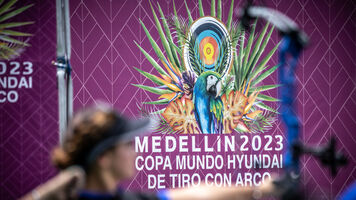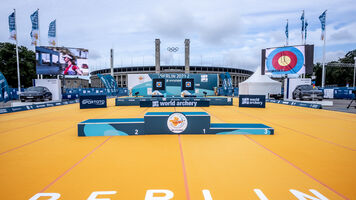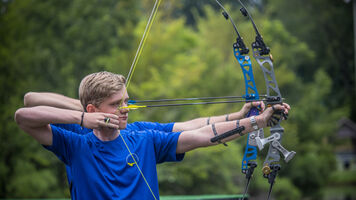What have we learned about the Tokyo 2020 Olympic archery venue?

The archery field at the Tokyo 2020 Olympic and Paralympic Games is in Yumenoshima Park. It is a green space that hosts a cluster of sports facilities in the southeast of the city in a region called Koto.
Half of the Games venue, the ranking round field, will remain as a permanent archery field after the Olympics.
The finals arena and its accompanying concessions, stands and office buildings are all temporary. They’ll be removed afterwards and the space will be converted into a running track according to the park map.
It’s a departure from the iconic venues used at the last two Games. Archery in Rio was staged in the Sambodromo, the carnival stadium that’s so deeply written in Carioca culture. Four years prior, in London, 200-year-old Lord’s Cricket Ground was used.
In the modern city of Tokyo, archery’s venue is new and bespoke. It is designed for the present and the future – and competitors at the Ready Steady Tokyo test event were the first from outside Japan to experience it.
At the Games themselves, practice opens approximately a week before the competition. This test is the only opportunity before then for Olympic hopefuls to learn about the environment and gain even the smallest competitive advantage.
Ranking round field
Home for the 128 athletes for most of the duration of their time at the Olympics, the ranking round field is used for practice as well as qualification.
If Jeon Ina’s score at the Ready Steady Tokyo test event is anything to go by, it could be a popular range. She led the women’s ranking round with 688 points under still but wet conditions.
“I think it’s going to be pretty protected but I think it’s going to be hard to read the wind,” said Brady Ellison. “All week it’s been a headwind. With the big back wall behind the targets, you don’t see it on the flags on the targets until it comes from the side and is a true sidewind.”
“So we’re going to have to rely a lot on feeling and then the flags on each side of the field. Overall, I think we’re going to be able to shoot some big scores on here.”
Big scores have become something of a recent tradition in the men’s competition at the Olympics.
Im Dong Hyun shot 699, a new world record, during qualification in London in 2012 and then Kim Woojin broke the 700-mark for the first and only time to date in Rio in 2016.
Can the level really rise for a third Games in a row?
If it does, whoever shoots 701-plus should have a star placed in the ground forever. Because this field, with its beautiful curving athlete shelter and observation office, is a permanent fixture. It’s archery’s legacy at Tokyo 2020.
The field is much wider than is necessary for the Games – where, at maximum in competition, only 32 targets are needed for 64 archers to shoot two-per-boss. With some space occupied by nearly a dozen short-distance warm-up targets at this test event, there was still enough room for 42 practice targets.
After the Games, Yumenoshima Park archery range should fit 64 targets in a row, if necessary.

Finals field
Every athlete at the Olympic Games receives 30 minutes to practise in the finals field before competition begins. It’s a process called familiarisation.
The only other time any archer can shoot in the Olympic arena is at this test event, one year prior. And yes, it is very different. There are no stands, the branding is temporary and the atmosphere is non-existent.
But it’s a chance to set a baseline understanding of the stage.
And that’s critical at the Games because unlike at other international archery tournaments, where early round matches are resolved on the ranking round field, every single head-to-head at the Olympics takes place in the arena. There’s no room to start slow. Every arrow counts.
“I think you do gain a certain amount of advantage just with familiarity. You’ve been there, you know kind of what to expect,“ said Brady. “Everything that we learn with the wind we can bring into next year. Whereas if you haven’t seen the field, your teammates can tell you about it but you’re still experiencing it for the first time.”
The shooting stage at the Games is expected to be about twice the size as that at the test event. Protected by flanking stands and a multitude of buildings outlined out on the ground in white this week, the dynamics of the wind flow are bound to change. But the impressiveness of the set-up is quite easy to imagine.
“I’m excited because I think Japan has a big archery history to it. And I’m excited because I think the fans here are gonna understand and know and want to come watch us compete,” said Brady. “I hope it’s loud. I want it to be so loud next year, so I’m excited for it.”

Transport
Tokyo is a massive city with excellent, if busy, public transport. Yumenoshima Park is situated right next to the Shin Kiba stop on the Keiyo, Rinkai and Yurakucho lines.
(There are a few small ramen, soba and udon noodle shops within the station itself. That’s valuable intel.)
It takes just 10 minutes to get into the centre of Tokyo on the fast train and only 30 to travel across the city to the famous Shibuya crossing. Athletes staying in the village are only a 20-minute drive away.
The Olympic venues for aquatics and canoe slalom are within a walkable distance from Yumenoshima Park. Volleyball, rowing and equestrian are only a little further away.
Archery will be in the heart of the Olympic atmosphere at Tokyo 2020. The competition fields, one built to serve the sport in the long term and one built for the spectacle of the Games, promise to deliver the elite environment in which athletes can perform at their very best.
‘Yumenoshima’ means ‘Dream Island’. The Tokyo 2020 Olympic Games are quickly becoming very real.
The Ready Steady Tokyo test event takes place on 11-18 July 2019 in the 2020 Olympic and Paralympic venue in Tokyo, Japan.










